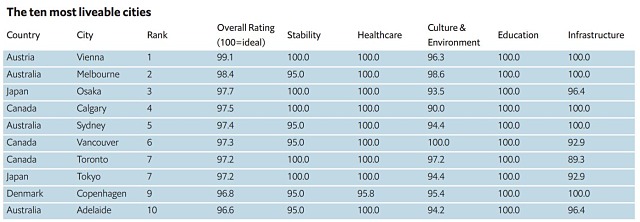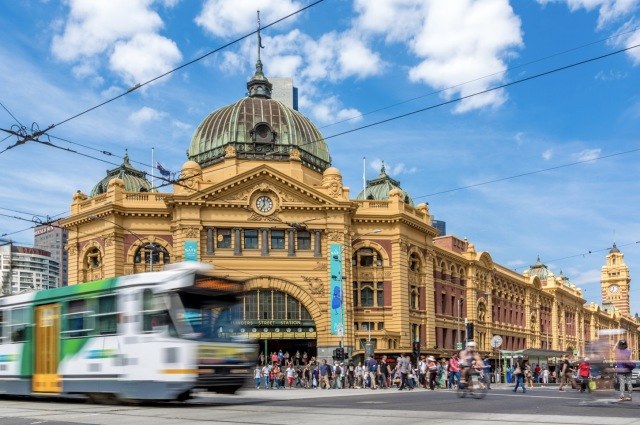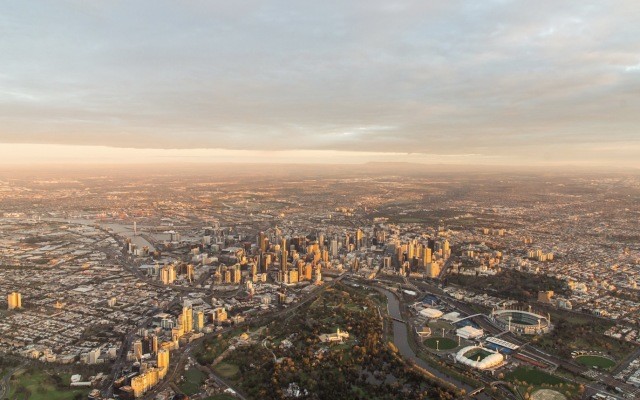Vienna tops Melbourne as world’s most liveable city

This is first time Austria’s capital, Vienna, has topped the EIU survey since it began in 2004, dethroning Melbourne of its seven year reign.
Melbourne has been usurped as the world’s most “liveable” city by Vienna, in an annual report published by The Economist Intelligence Unit (EIU), the research and analysis division of The Economist Group – the publishers of renowned weekly magazine ‘The Economist’.
Sydney was the voted as the second highest Australian city and ranked fifth overall.
Meanwhile, Adelaide was judged as the world’s 10th most liveable city, Perth was 14th while Brisbane was 22nd.
The top five cities according to the EIU report were Vienna, Melbourne, Osaka, Calgary and Sydney.

EIU’s rankings show that Australia now boasts five cities that rank in the top 25 world cities to live in.
When carrying out its research, the EIU survey considers over 30 factors related to safety, healthcare, educational resources, infrastructure and the environment.
Civil unrest, geopolitical tensions, trade wars, terror threats, political turmoil and financial imbalances have put strong pressure on policymakers across the world with standards of living either suffering (or improving) depending on the region.
From the cities looked at by the EIU, around 98 of the 140 cities surveyed have seen a drop in their “liveability” score since 2007.
This was largely put down to the impact of the global financial crisis in 2007-09 and the consequent “Age of Austerity” which has led to tightened government spending and reduced business investment in almost all developed countries.
Liveable competition
In the report, EIU says that Vienna is now the world’s most liveable city with Melbourne gazumped into second place – the first time Austria’s capital has topped the EIU’s survey since it began in 2004.
The two cities have been close contenders in the survey for over a decade and are regularly separated by less than a point.
“The two cities are now separated by 0.7%, with Vienna scoring a near-ideal 99.1 out of 100 and Melbourne scoring 98.4,” according to the EIU.

Flinders Street Station in Melbourne, Australia.
Melbourne has topped the rankings for the past seven editions, but a terror threat downgrade in western Europe, combined with a decline in Vienna’s crime rate, helped nudge Vienna into first place.
According to the report, “while in the past couple of years, cities in Europe were affected by the spreading perceived threat of terrorism in the region, which caused heightened security measures, the past year has seen a return to normalcy.”
Metropolis cities such as London, Paris, New York and Tokyo tend to have higher levels of crime, congestion and public transport problems – factors that are deemed to reduce the city’s perceived attraction and tarnish its “liveable” qualities.
Large cities, therefore, struggle to claim top spots in EIU’s survey – almost every single city in the top 10 sports a relatively low urban population of less than 3 million. In fact, Melbourne has the largest population in the top 10 with 4.8 million inhabitants, which accounts for almost 20% of Australia’s entire population.
The cities were ranked across five categories: infrastructure, stability, education, healthcare and culture and environment.
Given their leading positions, Vienna and Melbourne scored maximum points in the healthcare, education and infrastructure categories but had some differences in the “stability” and “culture” categories that helped Vienna reach top spot for the first time in seven years.
The EIU confirmed that Vienna had displaced Melbourne from top spot “due to increases in the Austrian capital’s stability category ratings.”
The survey has divided market commentators with some critics labelling the survey as “too subjective” while others admitting that Melbourne has some work to do to regain top spot.

Aerial view of Melbourne CBD.
“We’re a competitive bunch and I know that we’re all going to be working hard to make our way back up to number one in the future,” said Melbourne’s Lord Mayor Sally Capp.
However, Billie Giles-Corti from the RMIT’s Centre for Urban Research said that Melbourne did not deserve to lose top spot and neither had Vienna achieved anything to justify winning it.
According to Ms Giles-Corti, unsavoury public events in the past year involving so-called “African gangs”, a series of racist rants on Melbourne’s public transport system and last year’s property damage following the AFL Grand Final, could each have played a role in affecting Melbourne’s regular top-spot as number one.
“It’s not an objective measure. They ring up and get insights from their local informants,” said Ms Giles-Corti in an interview with ABC Radio.
“They ring up and have a chat to some bloke about how the city’s going. If that’s what we’re basing the rankings on, can they really be trusted?” she asked.
Slumming it
At the other end of the equality divide and judged to be the world’s least livable cities were Damascus in Syria, Dhaka in Bangladesh and Lagos and Nigeria.
Low scores on EIU’s survey indicate poor quality infrastructure, high political or economic instability, low levels of education, high mortality rates, poor access to health care and environmental risks such as flooding.
Cities that face extreme conditions and threats such as war including Baghdad and Kabul are not even included in the survey.
On a more positive note, the biggest improver from last year was Osaka in Japan.
“Osaka stands out especially, having climbed six positions, to third place, over the past six months, closing the gap with Melbourne,” the report stated.
“Osaka’s improvements in scores for quality and availability of public transportation, as well as a consistent decline in crime rates, have contributed to higher ratings in the infrastructure and stability categories respectively,” the report explained.
